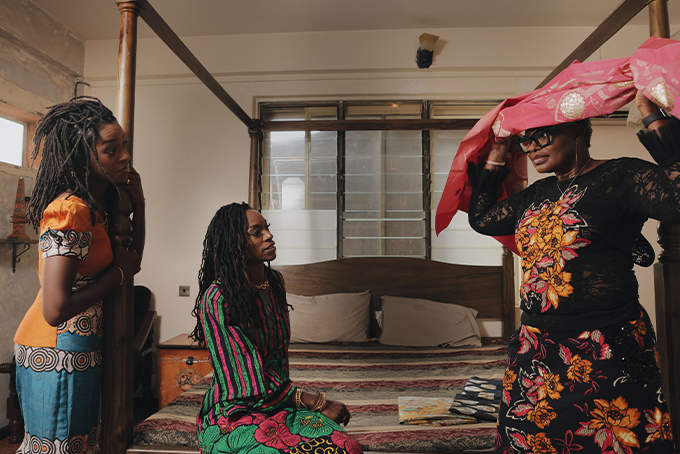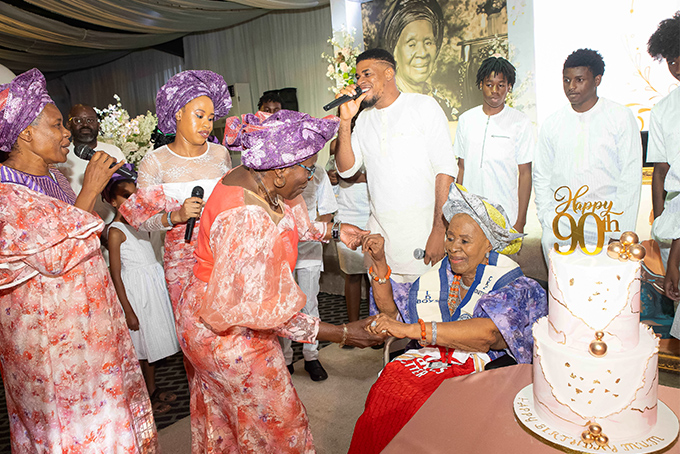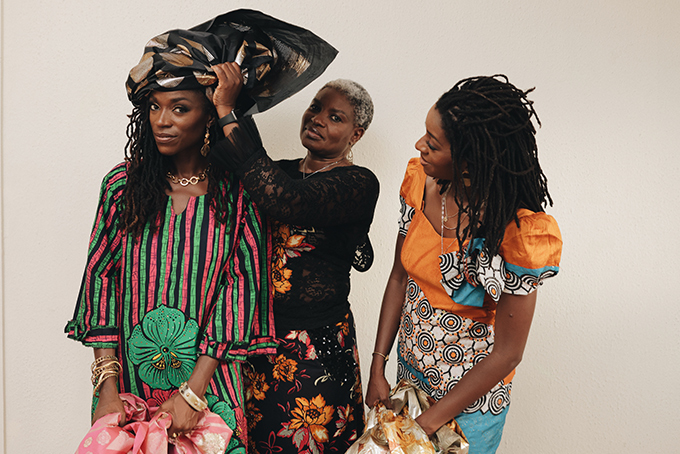I knew it was more than just attending my grandmother’s 90th birthday. It was a pilgrimage back to my roots. Prior to landing, I really had no idea what to expect. I had no clue what Lagos would look like or how it might be. After 16 years of being away, I was eager to reclaim my African identity and find a sense of belonging in my homeland, Nigeria. Over the course of two weeks, I turned each day into my own adventure with photographer Adedamola Odetara and art director Nosa Machi who captured beautiful moments alongside me.

During the vibrant celebration, I was introduced to the aso ebi (translated to ‘family cloth’) customs, unique to my Igbo and Yoruba culture. Aso ebi is a cultural tradition of my Yoruba family that involves a group of people wearing coordinated and uniform attire to mark a special occasion or event. As a fashion designer, finding inspiration for my creations is an essential part of my creative process. I am constantly on the lookout for unique and captivating elements that can infuse my designs with a fresh and exciting perspective. One such source of inspiration that has truly captured my imagination is Geles.
What is a Gele?

The headwrap, which is called Gele, is a part of a woman’s traditional attire in my culture. Female adults, typically aged 20 and above, wear the Gele as a sign of elegance and maturity. Women often wear a uniformed coloured Gele if they are among an organisation or at an event, such as a wedding or party.
Geles, with their intricate patterns and vibrant colours, possess a distinct allure that draws me in every time. The rich cultural heritage of Africa is beautifully reflected in these headwraps, making them a treasure trove of creativity for my designs. The mesmerising geometric patterns and bold hues offer endless creative possibilities, allowing me to infuse my garments with eye-catching designs and captivating colour combinations.

The elegant headwrap must have accompanying attire, jewellery and beads to match. I draw upon these elements to create cohesive and captivating collections that leave a lasting impression. The attire is typically imagined in a traditional style. The style is usually a lace blouse with a wrapper that must be wrapped with feet apart to help with walking once its tied.
Speaking with my Aunt Ogo, I realised the significance of the headwrap.“The Gele is not merely an accessory but a symbol of pride and beauty. Each addition to the outfit is meticulously chosen to complement and complete the entire look,” she shares.
Originally from the Yoruba tribe, it has now spread its charm throughout the continent. A proud symbol of femininity, the Gele is gracefully worn by women during festivities and joyous celebrations. Though the wearing of Gele is commonplace for women in the Nigerian culture, the two cultures that are especially noted for wearing the Gele in both its casual and sophisticated form are the Yoruba and Igbo cultures.
The use of Gele in the past
In the past, the Gele played a significant role, especially in the context of a woman’s marital status. I learned that wearing the Gele to the right signified marriage while wearing it to the left indicated being single. Moreover, the size of the Gele reflected one’s social standing, with larger Geles considered status symbols. However, as I delved deeper into the traditions, I discovered that these customs were prevalent in the past but no longer hold true today. The Gele has evolved beyond its symbolic representation of marital status and social hierarchy.

It used to be that the Gele was only worn with either the ‘Buba’ and ‘Iro’ (the Yoruba woman’s traditional attire), or, the Igbo woman’s ‘George Wrapper and Blouse’. Today, you can see the Gele being donned on all types of attire, such as skirt suits, pantsuits, and cocktail dresses. Geles have a timeless appeal that extends beyond traditional settings. I enjoy exploring how these headwraps can be adapted to modern styles while retaining their cultural essence. The possibilities are endless as the uses of the Gele are still emerging.
One aspect of Geles that I find particularly fascinating is the innovative draping and wrapping techniques required to achieve their distinctive shapes. As a fashion designer, I am constantly exploring and experimenting with different draping techniques to create silhouettes and breathe life into my designs. The artistry behind the construction of Geles inspires me to push the boundaries of conventional fashion and create pieces that are truly one of-a-kind. Tying the Gele is an art in itself. It takes great patience and precision.
Empowerment through Geles
Geles are more than just fashion accessories; they are symbols of pride, strength, and femininity. I find it rewarding to create pieces that empower individuals, and geles provide an excellent canvas for doing just that. When women wear geles, they often exude confidence and embrace their cultural identity, making a bold statement through their fashion choices. In modern Nigeria, the role of Gele has transformed, as shared by Aunt Ogo. Today, it goes beyond symbolism to embracing economic empowerment.
Ceremonies now feature professional Gele artists, creating job opportunities and offering a source of income for many locals. Gele has become not only a cherished cultural adornment but also a means of financial support, enriching lives in the community.
How is the Gele perceived these days?
The perception of Gele has evolved over time. Older ladies embrace the Gele tradition, cherishing the uniformity it brings and the sense of togetherness as they assist each other in donning the headwrap. Aunt Ogo emphasised that the Gele encourages sisterhood among women, completing their dressing with elegance.
The common Gele among the ladies brings awareness to their goal of promoting unity and expressions. Although the common Gele have similar colours, the women are free to make theirs at various heights based on their preference. Geles have a timeless appeal that extends beyond traditional settings. I enjoy exploring how these headwraps can be adapted to modern styles while retaining their cultural essence. The fusion of traditional and contemporary elements in my designs allows me to create garments that resonate with a broader audience, introducing them to the beauty of African aesthetics.

Moreover, I find inspiration in the sustainable practices associated with traditional Gele-making. Locally sourced materials and eco-friendly techniques offer valuable lessons for me as a designer. I actively explore the use of sustainable fabrics and ethical production methods in my work, aiming to make a positive impact on the environment and the fashion industry as a whole.
Gele as a form of identity
Gele, a powerful form of identity, weaves a sense of belonging within Nigerian communities. For some, the headscarf signifies their unique connection to religion. In church, the headwrap is a requirement, symbolising unity among women. They are symbols of pride, strength, and resilience. Incorporating geles into my designs is more than just a stylistic choice; it is a way for me to celebrate and honour the diverse African cultural heritage. Each Gele carries with it the essence of tradition, history, and identity. By infusing my designs with Geles, I feel a deep sense of responsibility to represent and preserve cultural diversity in the world of fashion. Gele is more than a fashion statement; it carries the strength of one’s roots and the beauty of embracing their true self.

In summary, Geles serve as a profound muse in my journey as a fashion designer. They fuel my creativity, appreciation for cultural heritage, and commitment to sustainability. By incorporating Geles into my designs, I aspire to showcase my heritage and the significance of the Gele in the Nigerian community, bridging the past and present. These practices are powerful symbols of culture, history, and identity and they hold the power to unify Nigerian women and remind us of our roots in this modern era. With OliveAnkara, I aim to empower women by embracing their cultural identity and overcoming personal struggles that many of you face, and I hope to inspire others to celebrate their origins and find strength in their journey of self-discovery.
Photography Adedamola Odetara
Director Nosa Machi
Make up Kuro Fred
Story Ify Ubby and the OliveAnkara team





